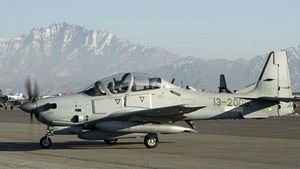Embraer/Sierra Nevada Corporation A-29 Super Tucano light attack aircraft are responsible for one third of all airstrikes conducted by the Afghan Air Force (AAF) in Afghanistan in support of ongoing military operations to defeat the Taliban insurgency, the Afghan Ministry of Defense (MoD) said over the weekend, according to local media reports.
The AAF launches on average 15 airstrikes per day in support of ground operations in the country. Out of the 15, five are typically conducted by A-29 Super Tucano light attack aircraft. (The vast majority of airstrikes are still launched by U.S. planes.) “These aircraft have a high speed and are accurate in targeting, which is all done through its electronic devices,” MoD spokesman Mohammad Radmanish said. “We mostly use these aircraft in the east, south, west and north of the country.”
The AAF is slated to operate 20 A-29s by the end of year, as I noted in March:
The U.S. Air Force has spent $427 million under its so-called Light Air Support/A-29 Afghanistan Program to supply the AAF with 20 A-29 aircraft by the end of this year. The AAF currently operates 12 aircraft with seven additional A-29 stationed at Moody Air Force Base in Georgia for pilot training. (One A-29 crashed during a test flight and still needs to be replaced.) The seven A-29s will be transferred to Afghanistan in the coming weeks.
In October 2017, the U.S. Department of Defense on behalf of the AAF placed a follow-up order of six A-29s with Brazilian aircraft maker Embraer Defense & Security. The per-unit price of one A-29 is around $18 million. The six additional aircraft are slated to be delivered to Afghanistan by the end of 2018. (The six extra aircraft require at least nine additional pilots and 20 maintainers.)
“The A-29 Super Tucano is a turboprop aircraft specifically designed for counter-insurgency operations and can be equipped with a wide array of bombs (including precision guided munitions) and machine guns,” I explained elsewhere. “The aircraft is fairly cheap to operate with one hour of flying time costing around $1,000.”
In March, an AAF A-29 aircraft dropped for the first time a GBU-58 laser-guided bomb during a close air support mission in the province of Farah in southwestern Afghanistan. Each A-29 can carry up to two 500-pound (226 kilogram) conventional or smart freefall bombs, next to short-range air-to-air missiles, machine guns and rockets.
The AAF has recently once more come under criticism for excessive civilian casualties. Earlier this month, as an airstrike carried out by AAF helicopters in the province of Kunduz killed dozens of Afghan civilians. The majority of the AAF’s fleet of Mi-24/Mi-35 attack helicopters are grounded due to missing spare parts. The bulk of airstrikes are conducted by MD530 F Cayuse Warrior light attack helicopters of which the AAF currently operates 27 with around 150 more on order.
As I noted in the past, these helicopters, however, still only use unguided munitions (2.75-inch rockets) and for the past years also lacked proper gun sights. (While this has been reportedly addressed, it is unclear whether all MD530s in service with the AAF have been retrofitted.) From 2017 to 2021, the AAF is slated to receive over $7 billion in support from the U.S. government. The AAF is expected to grown in size from 124 aircraft to 259, and from 8,000 personnel to 12,000 in the coming years.
The readiness rate for AAF aircraft remains classified.
































